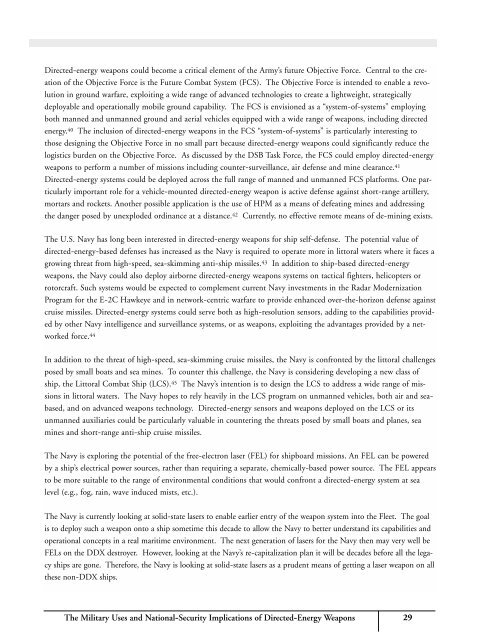directed-energy-weapons
directed-energy-weapons
directed-energy-weapons
You also want an ePaper? Increase the reach of your titles
YUMPU automatically turns print PDFs into web optimized ePapers that Google loves.
Directed-<strong>energy</strong> <strong>weapons</strong> could become a critical element of the Army’s future Objective Force. Central to the creationof the Objective Force is the Future Combat System (FCS). The Objective Force is intended to enable a revolutionin ground warfare, exploiting a wide range of advanced technologies to create a lightweight, strategicallydeployable and operationally mobile ground capability. The FCS is envisioned as a “system-of-systems” employingboth manned and unmanned ground and aerial vehicles equipped with a wide range of <strong>weapons</strong>, including <strong>directed</strong><strong>energy</strong>. 40 The inclusion of <strong>directed</strong>-<strong>energy</strong> <strong>weapons</strong> in the FCS “system-of-systems” is particularly interesting tothose designing the Objective Force in no small part because <strong>directed</strong>-<strong>energy</strong> <strong>weapons</strong> could significantly reduce thelogistics burden on the Objective Force. As discussed by the DSB Task Force, the FCS could employ <strong>directed</strong>-<strong>energy</strong><strong>weapons</strong> to perform a number of missions including counter-surveillance, air defense and mine clearance. 41Directed-<strong>energy</strong> systems could be deployed across the full range of manned and unmanned FCS platforms. One particularlyimportant role for a vehicle-mounted <strong>directed</strong>-<strong>energy</strong> weapon is active defense against short-range artillery,mortars and rockets. Another possible application is the use of HPM as a means of defeating mines and addressingthe danger posed by unexploded ordinance at a distance. 42 Currently, no effective remote means of de-mining exists.The U.S. Navy has long been interested in <strong>directed</strong>-<strong>energy</strong> <strong>weapons</strong> for ship self-defense. The potential value of<strong>directed</strong>-<strong>energy</strong>-based defenses has increased as the Navy is required to operate more in littoral waters where it faces agrowing threat from high-speed, sea-skimming anti-ship missiles. 43 In addition to ship-based <strong>directed</strong>-<strong>energy</strong><strong>weapons</strong>, the Navy could also deploy airborne <strong>directed</strong>-<strong>energy</strong> <strong>weapons</strong> systems on tactical fighters, helicopters orrotorcraft. Such systems would be expected to complement current Navy investments in the Radar ModernizationProgram for the E-2C Hawkeye and in network-centric warfare to provide enhanced over-the-horizon defense againstcruise missiles. Directed-<strong>energy</strong> systems could serve both as high-resolution sensors, adding to the capabilities providedby other Navy intelligence and surveillance systems, or as <strong>weapons</strong>, exploiting the advantages provided by a networkedforce. 44In addition to the threat of high-speed, sea-skimming cruise missiles, the Navy is confronted by the littoral challengesposed by small boats and sea mines. To counter this challenge, the Navy is considering developing a new class ofship, the Littoral Combat Ship (LCS). 45 The Navy’s intention is to design the LCS to address a wide range of missionsin littoral waters. The Navy hopes to rely heavily in the LCS program on unmanned vehicles, both air and seabased,and on advanced <strong>weapons</strong> technology. Directed-<strong>energy</strong> sensors and <strong>weapons</strong> deployed on the LCS or itsunmanned auxiliaries could be particularly valuable in countering the threats posed by small boats and planes, seamines and short-range anti-ship cruise missiles.The Navy is exploring the potential of the free-electron laser (FEL) for shipboard missions. An FEL can be poweredby a ship’s electrical power sources, rather than requiring a separate, chemically-based power source. The FEL appearsto be more suitable to the range of environmental conditions that would confront a <strong>directed</strong>-<strong>energy</strong> system at sealevel (e.g., fog, rain, wave induced mists, etc.).The Navy is currently looking at solid-state lasers to enable earlier entry of the weapon system into the Fleet. The goalis to deploy such a weapon onto a ship sometime this decade to allow the Navy to better understand its capabilities andoperational concepts in a real maritime environment. The next generation of lasers for the Navy then may very well beFELs on the DDX destroyer. However, looking at the Navy’s re-capitalization plan it will be decades before all the legacyships are gone. Therefore, the Navy is looking at solid-state lasers as a prudent means of getting a laser weapon on allthese non-DDX ships.The Military Uses and National-Security Implications of Directed-Energy Weapons29


